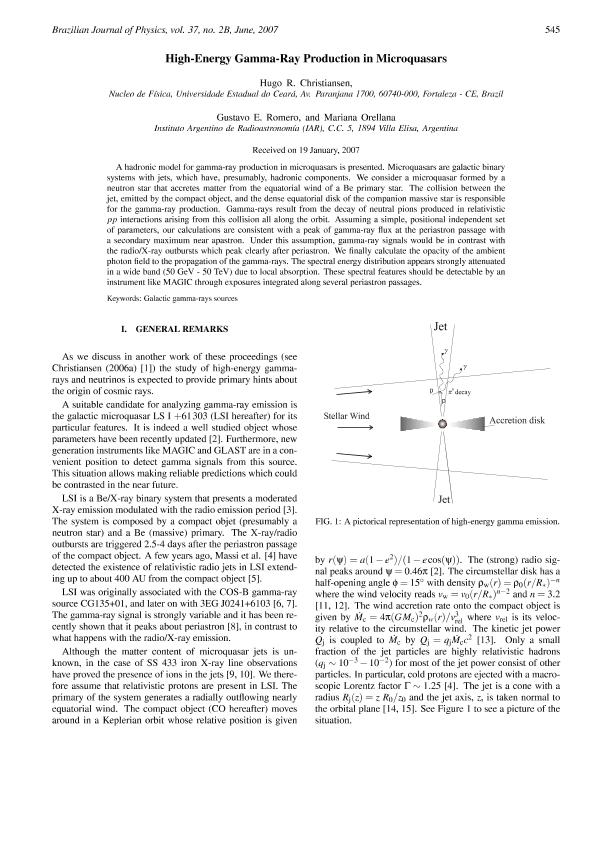Mostrar el registro sencillo del ítem
dc.contributor.author
Christiansen, Hugo

dc.contributor.author
Romero, Gustavo Esteban

dc.contributor.author
Orellana, Mariana Dominga

dc.date.available
2017-08-14T19:13:56Z
dc.date.issued
2007-12
dc.identifier.citation
Christiansen, Hugo; Romero, Gustavo Esteban; Orellana, Mariana Dominga; High-energy gamma-ray production in microquasars; Soc Brasileira Fisica; Brazilian Journal Of Physics; 37; 2B; 12-2007; 545-548
dc.identifier.issn
1678-4448
dc.identifier.uri
http://hdl.handle.net/11336/22323
dc.description.abstract
A hadronic model for gamma-ray production in microquasars is presented. Microquasars are galactic binary systems with jets, which have, presumably, hadronic components. We consider a microquasar formed by a neutron star that accretes matter from the equatorial wind of a Be primary star. The collision between the jet, emitted by the compact object, and the dense equatorial disk of the companion massive star is responsible for the gamma-ray production. Gamma-rays result from the decay of neutral pions produced in relativistic pp interactions arising from this collision all along the orbit. Assuming a simple, positional independent set of parameters, our calculations are consistent with a peak of gamma-ray flux at the periastron passage with a secondary maximum near apastron. Under this assumption, gamma-ray signals would be in contrast with the radio/X-ray outbursts which peak clearly after periastron. We finally calculate the opacity of the ambient photon field to the propagation of the gamma-rays. The spectral energy distribution appears strongly attenuated in a wide band (50 GeV - 50 TeV) due to local absorption. These spectral features should be detectable by an instrument like MAGIC through exposures integrated along several periastron passages.
dc.format
application/pdf
dc.language.iso
eng
dc.publisher
Soc Brasileira Fisica

dc.rights
info:eu-repo/semantics/openAccess
dc.rights.uri
https://creativecommons.org/licenses/by-nc-sa/2.5/ar/
dc.subject
Microquasars
dc.subject
Gamma Rays
dc.subject
Hadronic Models
dc.subject
Binary Systems
dc.subject
Galactic Gamma-Rays Sources
dc.subject.classification
Otras Ciencias Físicas

dc.subject.classification
Ciencias Físicas

dc.subject.classification
CIENCIAS NATURALES Y EXACTAS

dc.title
High-energy gamma-ray production in microquasars
dc.type
info:eu-repo/semantics/article
dc.type
info:ar-repo/semantics/artículo
dc.type
info:eu-repo/semantics/publishedVersion
dc.date.updated
2017-05-18T21:20:31Z
dc.journal.volume
37
dc.journal.number
2B
dc.journal.pagination
545-548
dc.journal.pais
Brasil

dc.journal.ciudad
San Pablo
dc.description.fil
Fil: Christiansen, Hugo. Universidade Estadual Do Ceara; Brasil
dc.description.fil
Fil: Romero, Gustavo Esteban. Provincia de Buenos Aires. Gobernación. Comision de Investigaciones Científicas. Instituto Argentino de Radioastronomía. Consejo Nacional de Investigaciones Científicas y Técnicas. Centro Científico Tecnológico Conicet - La Plata. Instituto Argentino de Radioastronomia; Argentina
dc.description.fil
Fil: Orellana, Mariana Dominga. Provincia de Buenos Aires. Gobernación. Comision de Investigaciones Científicas. Instituto Argentino de Radioastronomía. Consejo Nacional de Investigaciones Científicas y Técnicas. Centro Científico Tecnológico Conicet - La Plata. Instituto Argentino de Radioastronomia; Argentina
dc.journal.title
Brazilian Journal Of Physics

dc.relation.alternativeid
info:eu-repo/semantics/altIdentifier/url/http://ref.scielo.org/gsfhzh
dc.relation.alternativeid
info:eu-repo/semantics/altIdentifier/doi/http://dx.doi.org/10.1590/S0103-97332007000400012
Archivos asociados
